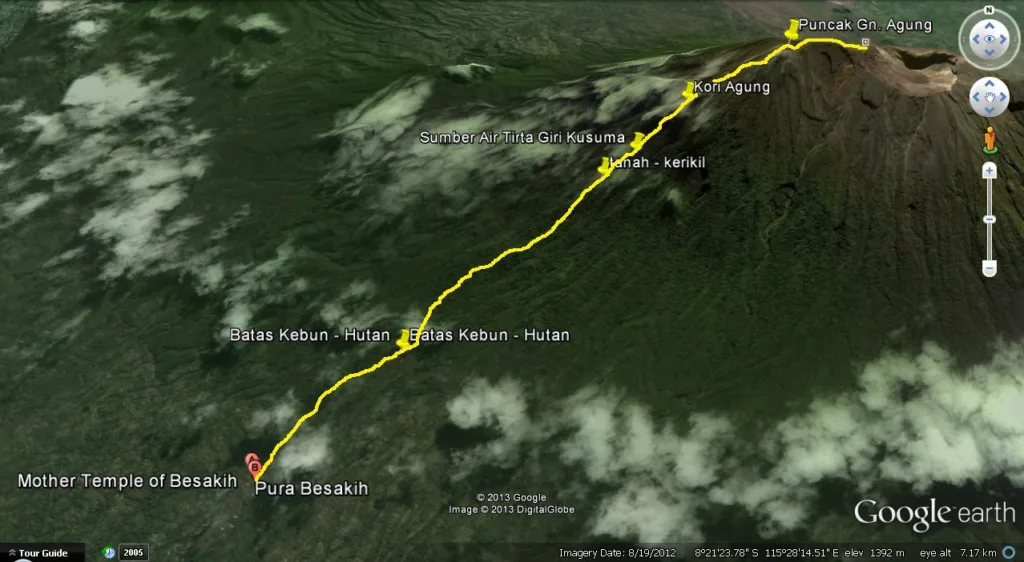Climbing Mount Agung Conquering a Sacred Mountain in Indonesia
Introduction
Mount Agung, undeniably a revered mountain in Indonesia, towers over the island of Bali, casting an imposing shadow both geographically and spiritually. As Bali’s highest point, it not only presents an enticing challenge for mountaineers but also holds a deep spiritual significance for the locals. At its heart, the Mother Temple of Besakih, the largest and holiest temple in Bali, stands as a testament to Agung’s sacred status.

Mount Agung’s Geographical Spotlight
Among the panoramic range of mountains in Indonesia, Mount Agung holds a distinct position. Located on the eastern side of Bali, its majestic presence influences the island’s weather, making the western side drier. Geologically, this active volcano’s history is a narrative of powerful eruptions, with the recent one in 2017. Its continuous activity and the surrounding landscapes make it a unique mountain in Indonesia, attracting geologists and nature enthusiasts alike.

Preparation for the Ascension
Physical preparedness is paramount for those aspiring to tackle this challenging mountain trekking expedition in Indonesia. A good stamina base coupled with altitude hiking training can make the ascent more manageable and enjoyable. As for gear, given Mount Agung’s varied terrains, climbers need to equip themselves with sturdy boots, appropriate clothing layers, and necessary hydration supplies. The sacred nature of the mountain requires climbers to also familiarize themselves with local customs. Climbers should secure necessary permits and, if opting to climb during religious ceremonies, respect local traditions and rituals associated with this sacred Indonesian mountain.

Climbing Paths and Routes
Mount Agung boasts multiple routes, each offering a unique perspective of this towering mountain in Indonesia. The most popular is the Besakih route, starting from the Mother Temple, providing both a spiritual and physical journey. Another notable trail begins at Pura Pasar Agung, leading to the crater’s rim. Each route varies in difficulty, offering climbers options depending on their experience and desired challenge. Regardless of the chosen path, the panoramic views of Bali and beyond are a rewarding sight.

Safety and Climatic Considerations
Given its active volcanic status, staying updated on any volcanic alerts is crucial for anyone attempting to climb this mountain in Indonesia. The local authorities often issue warnings and advisories, especially when there’s increased volcanic activity. Climatically, the best months to ascend are between April and October, avoiding Bali’s rainy season, which can make the trails treacherous. It’s also colder at higher altitudes, so appropriate warm clothing is essential.

Cultural Respect and Awareness
Beyond its geographical might, Mount Agung stands as a beacon of Balinese spirituality. Climbers should approach their ascent with an understanding of this mountain’s deep cultural roots in Indonesia. Engaging with local guides not only ensures a safe trek but also offers insights into the mountain’s rich tapestry of legends and traditions.

Accommodations and Provisions
The regions surrounding Mount Agung offer a variety of accommodations ranging from local homestays to more luxurious lodges. These cater to trekkers and tourists wanting to experience mountains in Indonesia, especially the mighty Agung. As for gastronomy, Bali’s rich culinary traditions offer climbers an array of dishes to indulge in, from savory Lawar to the sweet delight of Klepon.
Conclusion
Ascending Mount Agung is more than just a physical endeavor; it’s a journey through Bali’s spiritual heart, offering climbers a unique blend of adventure and cultural immersion. As with all mountains in Indonesia, the experience becomes richer with respect for local customs and an insatiable curiosity.
Further Resources
For those keen on a deeper dive into Mount Agung’s history and significance, various books and documentaries elucidate its mysteries. Online platforms, like the Indonesian Mountain Federation’s website, offer valuable trekking insights. Lastly, considering the mountain’s sacred and challenging nature, opting for experienced local guides and trekking agencies, like Bali Trekking Tours, can enhance the overall climbing experience.
Climbing Mount Agung - Conquering a Sacred Mountain in Indonesia
Ascending Mount Agung is a transformative journey, blending physical challenge with spiritual significance. The awe-inspiring summit, cultural richness, and a sense of accomplishment make it a unique adventure. However, the demanding climb warrants preparation and respect for the sacred context.
Pros
- Majestic Summit Views
- Spiritual Connection to a Sacred Volcano
- Cultural Insights Facilitated by Local Guides
Cons
- Demanding Climb, Suitable for Experienced Hikers
- Adherence to Local Traditions is Essential, Requiring Visitor Sensitivity


